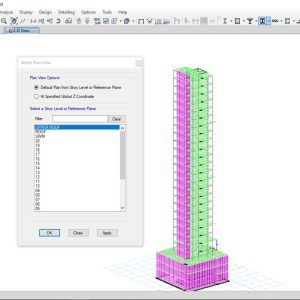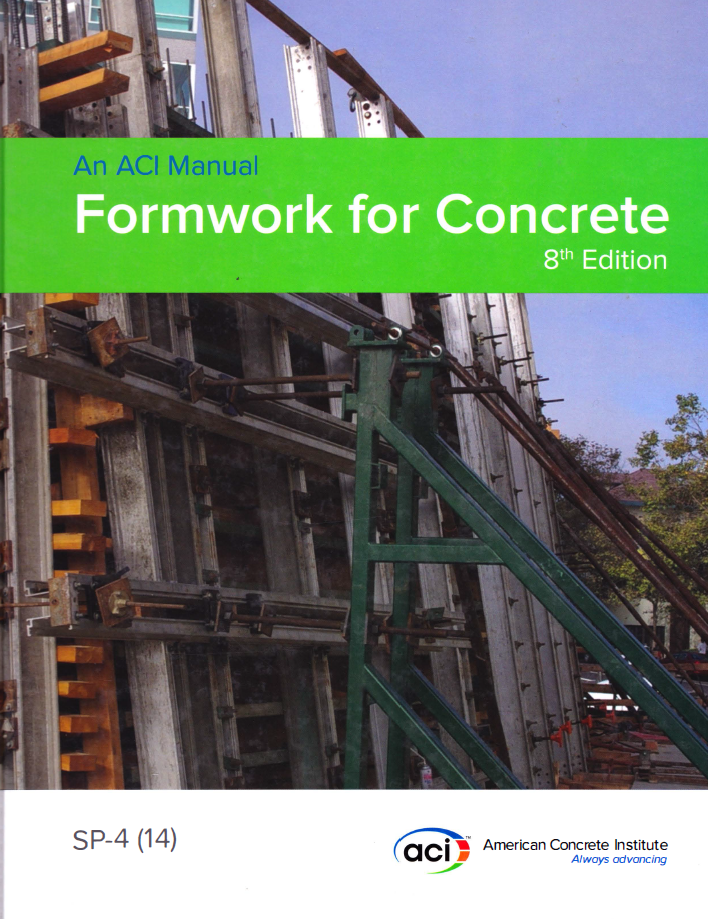-
 MS Office Professional Essential Training$200.00
MS Office Professional Essential Training$200.00 -
 Primavera P6 Professional Training Course$250.00
Primavera P6 Professional Training Course$250.00 -
Product on sale
 20+ Story High Rise BuildingOriginal price was: $39.99.$9.99Current price is: $9.99.
20+ Story High Rise BuildingOriginal price was: $39.99.$9.99Current price is: $9.99. -
 CSI SAFE Essential Training Course$250.00
CSI SAFE Essential Training Course$250.00 -
 CSI ETABS Essential Training Course$350.00
CSI ETABS Essential Training Course$350.00
The 8th Edition, authored by David W. Johnston, North Carolina State University, is a major revision of the document to bring it up-to-date with “Guide to Formwork for Concrete (ACI 347R-14).” Revisions include referencing current standards and practices, removing outdated or irrelevant material, adding content on new developments in formwork technology and practice, and updating the look and layout of the document.
This edition considers the updated lateral pressure and other provisions now provided by ACI 347R-14. Expanded coverage is provided in SP-4 for wind loads on formwork specialized from ASCE/SEI 7-10 as modified by ASCE/SEI 37-14. The design of formwork has been divided into two chapters, one focusing on bending, shear, and deflection of wall, slab, and column formwork members, and a second focusing on shoring and bracing members. Bridge formwork considerations have been moved into a separate chapter. A new chapter summarizing the recommendations of ACI 347.3R-13, “Guide to Formed Concrete Surfaces,” has been added.
Benefits of the 8th Edition include:
– An ACI best-selling document – Allowable strength design and load and resistance factor design examples – Updated to current standards – Chapter problems for classroom study – 500 modern color photographs – 150 color illustrations – Includes ACI 347R-14
Keywords:architectural concrete; bridge construction; building construction, concrete construction; construction; construction loads; construction materials; falsework; forms; formwork; formed surfaces, mass concrete; precast concrete; prestressed concrete; quality control; reinforced concrete; reshoring; shoring; slipform construction; tunnels
DOCUMENT DETAILS Author: David W. Johnston
Publication Year: 2014 Pages: 512 ISBN: 9780870319129 Categories: Construction Practices, Formwork Formats: Printed Document or Protected PDF/Web View
TABLE OF CONTENTS
1: INTRODUCTION 2: GENERAL OBJECTIVES IN FORMWORK BUILDING 2.1 Standards, Specifications, and Guides Related to Formwork 2.1.1 Regulations for Safety 2.1.2 Project Specifications for Quality 2.1.3 Guides and Specifications for Formwork Design and Construction 2.2 How Formwork Affects Concrete Quality 2.3 Planning for Safety 2.3.1 Supervision and Inspection 2.3.2 Platforms and Access for Workers 2.3.3 Control of Concreting Practices 2.3.4 Improving Soil Bearing and Bracing 2.3.5 Shoring and Reshoring 2.4 Causes of Failures 2.4.1 Improper Stripping and Shore Removal 2.4.2 Inadequate Bracing 2.4.3 Inadequate Concrete Strength Development 2.4.4 Vibration and Impact 2.4.5 Unstable Soil under Mudsills, Shoring Not Plumb 2.4.6 Inadequate Control of Concrete Placement 2.4.7 When Formwork Is Not at Fault 2.4.8 Lack of Attention to Formwork Details 2.5 Relationship of Architect, Engineer, and Contractor 2.5.1 Defining the Concrete Structure 2.5.2 Maintaining and Coordinating Tolerances 2.5.3 Preparing a Formwork Specification 2.5.4 Design, Inspection, and Approval of Formwork 2.5.5 Complex Structures 2.5.6 Stay-in-Place Forms 2.5.7 Composite Construction 2.5.8 Stripping and Decentering 2.5.9 Materials and Accessories Related to Formed Surface of Exposed Concrete 2.6 Achieving Economy of Formwork 2.6.1 Measurement and Payment for Formwork 2.6.2 How the Engineer/Architect Can Reduce Form Costs 3: OVERALL PLANNING 3.1 Development of a Basic System 3.1.1 Compare Alternate Methods 3.1.2 Examine Form Plan in Relation to Total Job 3.2 Key Areas of Cost Reduction 3.3 Planning for Maximum Reuse 3.3.1 Developing a Practical Reuse Plan 3.3.2 Comparing Reuse Schemes 3.4 Economical Form Construction 3.4.1 Job-Built Forms 3.4.2 Purchased or Rented Forms 3.5 Setting, Stripping, and Cycling Costs 3.6 Other Costs Affected by the Formwork Plan 3.6.1 Crew Efficiency 3.6.2 Cranes and Hoists 3.7 Formwork Planning Process 3.8 BIM for Planning Formwork Operations 3.8.1 How BIM is Used by a Formwork Contractor 3.8.2 Advantages of BIM 4: MATERIALS, ACCESSORIES, AND PROPRIETARY PRODUCTS 4.1 Lumber 4.1.1 Kinds of Lumber 4.1.2 Lumber Finish and Sizes 4.1.3 Stress Grading and Design Values 4.1.4 Adjustment Factors for Sawn Lumber Design Values 4.2 Engineered Wood Products 4.2.1 Glued Laminated Timber 4.2.2 Structural Composite Lumber 4.2.3 I-Joists 4.2.4 Wood Trusses 4.3 Plywood 4.3.1 Construction and Sizes Available 4.3.2 Types and Grades 4.3.3 Overlaid Plywood 4.3.4 Textured Surfaces 4.3.5 Strength Properties 4.3.6 Bending Plywood to Curved Surfaces 4.4 Other Framing and Facing Materials 4.4.1 Reconstituted Wood Materials 4.4.2 Steel 4.4.3 Aluminum 4.4.4 Glass Fiber-Reinforced Polymer 4.4.5 Other Polymeric Form Materials 4.4.6 Fabric and Porous Forms 4.4.7 Form Lining Materials 4.4.8 Insulation and Insulating Forms 4.5 Hardware and Fasteners 4.5.1 Nails 4.5.2 Wood Screws 4.5.3 Bolts, Lag Screws, and Other Connectors 4.5.4 Ties 4.5.5 Anchors 4.5.6 Hangers 4.5.7 Friction Collars and Support Brackets 4.5.8 Spacers and Spreaders 4.5.9 Steel Strapping 4.5.10 Column Clamps 4.6 Prefabricated Forms 4.6.1 Panel Forms and Forming Systems 4.6.2 Pans and Domes for Concrete Joist Construction 4.6.3 Void and Duct Forms 4.6.4 Column Forms 4.6.5 Stay-In-Place Forms 4.6.6 Special Purpose and Custom-Made Forms 4.7 Shoring 4.7.1 Single-Post Shores 4.7.2 Shoring Frames 5: LOADS AND PRESSURES 5.1 Notation for Loads and Pressures 5.2 Load Combinations 5.2.1 ASD Combinations 5.2.2 LRFD Combinations 5.3 Vertical Loads 5.3.1 Dead Loads 5.3.2 Live Loads 5.4 Lateral Pressure of Fresh Concrete 5.4.1 Factors Affecting Lateral Pressure 5.4.2 History of Lateral Pressure Values for Form Design 5.4.3 Lateral pressure of concrete equations 5.4.4 Bottom-Up Pumping of Concrete 5.4.5 Column Forms 5.4.6 Wall Forms 5.4.7 Pressure on Sloping Surfaces 5.5 Horizontal Loads 5.5.1 Minimum Horizontal Loads 5.5.2 Wind Loads 5.5.3 Shielding from Wind Pressure 5.5.4 Design Wind Load 5.5.5 Wind Load on Wall and Column Forms 5.5.6 Wind Loads on Elevated Slab Formwork 5.5.7 Starting and Stopping Equipment Loads 5.5.8 Seismic Loads 5.6 Other Loads 6: SHORING AND FLOOR LOADS IN MULTI-STORY STRUCTURES 6.1 Shoring of Multi-story Concrete Structures during Construction 6.2 Shoring and Reshoring Loads in Multi-story Structures 6.2.1 Analyzing the Loads 6.2.2 Comparison of Example Analysis Results 6.3 Backshoring 6.4 Drophead Shores 6.5 LRFD Analysis 6.6 Shoring System Design 6.7 Determining Concrete Strength for Stripping and Loading for Cycle Times 6.7.1 Analysis and Design Process for Slab Strength 6.7.2 Alternative Load Distributions 6.7.3 More Concentrated Shore Loads 6.7.4 Structures Designed for Composite Action 6.7.5 Post-Tensioned Structures 6.8 Effect of Early Loading on Slab Deflection 6.9 Monitoring Early Strength Gain of Concrete in the Field 6.9.1 Field-Cured Cylinders 6.9.2 Alternate Tests 7: DESIGN OF SLAB, WALL, BEAM, AND COLUMN FORMS 7.1 Notation 7.2 Basic Simplifications 7.3 Beam Formulas 7.4 Design Criteria for Wood Beams 7.4.1 Stresses and Deformations 7.4.2 Bending 7.4.3 Deflection 7.4.4 Shear 7.4.5 Bearing 7.5 Form Design 7.6 Wall Form Design 7.7 Slab Form Design 7.8 Beam Form Design 7.9 Column Form Design 7.9.1 Types of Column Forms 7.9.2 General Design Procedure 7.10 Form Accessories 7.10.1 Ties 7.10.2 Bearing Plates or Washers 7.10.3 Hangers 8: DESIGN OF FORM SHORES AND BRACING 8.1 Shoring and Bracing Members 8.2 Solid Wood Compression Members 8.3 Tubular Steel Shores 8.3.1 Slenderness Ratio 8.3.2 Compression Strength 8.3.3 Steel Shoring Frames 8.4 Other Manufactured Shoring Devices 8.5 Support for Shoring 8.6 Bracing for Lateral Loads 8.6.1 Wall Form Bracing Loads 8.6.2 Design of Braces 8.6.3 Bracing of Slab Forms Supported by Individual Shores 8.6.4 Design of Wood Bracing Connections 8.7 Camber and Adjustment for Settlement 8.7.1 Anticipated Deflection or Settlement of Formwork 8.7.2 Deflection of the Finished Structure 8.7.3 Total Allowance for Camber and Adjustments 8.8 Anchorage of braces 8.8.1 Deadmen 8.8.2 Concrete anchors 8.8.3 Ground anchors 8.8.4 Anchors 9: DESIGN TABLES 9.1 Equations for Calculating Safe Span 9.2 Sheathing Design: Tables 9.3 to 9.5 9-4 9.3 Joists, Studs, and Beams: Tables 9.4 to 9.8 9-4 9.4 Double Members: Tables 9.9 to 9.11 9-5 9.5 Wood Shores: Tables 9.12 and 9.13 9-5 9.6 Form Design Using the Tables 9-7 10: FORMWORK DRAWINGS 10.1 Preparing Effective Drawings 10.2 Line Drawings 10.3 General Layout and Detail Drawings 10.4 Checklist of Details 10.5 Recheck for Agreement with Structural Drawings 10.6 Drawing Review 10.7 BIM 3-D Graphical Views of Formwork 11: BUILDING AND ERECTING THE FORMWORK 11.1 Form Fabrication 11.1.1 Location of Shop at Project Site 11.1.2 Storage of Materials and Finished Parts 11.1.3 Equipment and Layout 11.2 Formwork Erection Safety 11.3 Footings 11.3.1 Wall Footings 11.3.2 Column Footings 11.4 Slab-on-Ground and Paving Work 11.4.1 Slabs-on-Ground 11.4.2 Highway and Airport Paving 11.4.3 Curb and Gutter Forms 11.5 Wall Forms 11.5.1 Job-Built Forms 11.5.2 Prefabricated Panel Systems 11.5.3 Ganged Panel Forms and Climbing Forms 11.5.4 Blind Side and Single-Side Wall Forming 11.5.5 Square Corners 11.5.6 Pilasters 11.5.7 Curved Walls and Round Corners 11.5.8 Wall Openings 11.5.9 Joints 11.5.10 Forms for External Vibration 11.5.11 ACI Tolerances for Walls 11.6 Column Forms 11.6.1 Erection Practices 11.6.2 Square or Rectangular Columns 11.6.3 Round and Flared Columns 11.6.4 Column Heads 11.6.5 ACI Column Tolerances 11.7 Beam or Girder Forms 11.7.1 Beam Bottoms 11.7.2 Beam Sides 11.7.3 Panel Assembly and Erection 11.7.4 Suspended Forms for Fireproofing and Composite Construction 11.7.5 Beam and Girder Tolerances 11.8 Slab Forms 11.8.1 Beam and Slab Construction 11.8.2 Flat Plates and Flat Slabs 11.8.3 Concrete Joist Construction 11.8.4 Flying Form Systems 11.8.5 Adjustable Steel Beams 11.8.6 Slabs Supported on Steel Beams or Precast Concrete Beams 11.8.7 Metal Decking 11.8.8 ACI Tolerances for Slab Work 11.9 Shoring 11.9.1 Shore Layout and Installation 11.9.2 Mudsills or Shoring Foundations 11.9.3 Wood Shores 11.9.4 Adjustable Shores 11.9.5 Drophead Shore Systems 11.9.6 Shoring Towers 11.9.7 Adjustment and Jacking 11.9.8 Permanent Shores and Back Shores 11.9.9 Composite Construction 12: USING THE FORMS 12.1 Placing Reinforcement and Inserts 12.1.1 Support for Reinforcing Bars 12.1.2 Positioning Bars; Placement Tolerances 12.2 Preparation for Concreting 12.2.1 Form Release Agents 12.2.2 Sticking and Staining Problems 12.2.3 Use of Water on the Forms 12.3 Inspection and Form Watching 12.3.1 Before Concreting 12.3.2 During and After Concreting 12.4 Placing and Vibrating—Effect on Formwork 12.5 Removal of Forms and Shores 12.5.1 Stripping Time Based on Concrete Strength 12.5.2 Form Removal Related to Curing Needs 12.5.3 Stripping Techniques 12.5.4 Multi-Story Buildings 12.6 Reshoring 12.7 Care and Storage of Forms and Accessories 12.8 Cold Weather Protection 12.8.1 Form Insulation and Heating 12.8.2 Avoiding Thermal Shock 13: FORMED CONCRETE SURFACE QUALITY 13.1 Overview of ACI 301 Formed Surface Provisions 13.1.1 General Requirements 13.1.2 As-Cast Surface Finishes 13.1.3 Rubbed Surface Finishes 13.2 Overview of ACI 347.3R Formed Concrete Surface Provisions 13.2.1 Determination of Surface Void Ratio 13.2.2 Specifications 13.2.3 Design Considerations 13.2.4 Construction 13.2.5 Evaluation of formed concrete surfaces and repair procedures 14: FORMWORK FOR ARCHITECTURAL CONCRETE 14.1 Specifications: Defining Quality 14.2 Architectural Formwork Design 14.2.1 Loads and Pressures 14.2.2 Design Standards 14.2.3 Formwork Details 14.3 Exposed Concrete Surfaces 14.3.1 Smooth As-Cast Surfaces 14.3.2 Textured As-Cast Surfaces 14.3.3 Precast Panels as Forms or Liners 14.4 Construction of Forms for Architectural Concrete 14.4.1 Walls 14.4.2 Columns and Pilasters 14.4.3 Spandrels and Parapets 14.4.4 Soffits 14.4.5 Cantilevers 14.4.6 Ornamental Detail 14.4.7 Erection Practices 14.4.8 Construction and Contraction Joints 14.5 Stripping 14.6 Cleanup and Repair 15: BRIDGE FORMWORK 15.1 Foundations 15.1.1 Caissons 15.1.2 Piles 15.1.3 Rock or Soil Offering Direct Support 15.2 Piers 15.2.1 Forms Moved for Reuse 15.2.2 Round Piers 15.2.3 Stonework Facing 15.2.4 Massive Piers 15.2.5 Vertical Alignment 15.2.6 Access for Workers 15.2.7 External Ties 15.2.8 Pier Caps and Tie Struts 15.3 Superstructures 15.3.1 Monolithic—Simple Slab, Beam, and Girder 15.3.2 Cast-in-Place Deck Supported on Steel or Precast Girders 15.3.3 Expansion Joints 15.3.4 Overhang, Sidewalks, Parapets, and Median Barriers 15.3.5 Support for Superstructure Forms 15.3.6 Stripping Bridge Forms 15.4 Arch Bridges 15.5 Segmental Box-Girder Bridge Construction 15.5.1 Cast-in-Place Segmental Construction 15.5.2 Precast Segmental Construction 15.5.3 Principal Erection Methods 15.5.4 Making Precast Bridge Segments 15.5.5 Voids, Inserts, Attachments 15.5.6 Joint Surfaces 15.5.7 Vibration 15.5.8 Heat Curing Considerations 15.5.9 Tolerance Requirements 16: MASS CONCRETE FORMWORK 16.1 Types of Cantilever Forms in Common Use 16.2 Design Considerations 16.2.1 Loads on the Formwork 16.2.2 Anchorage Accessories 16.2.3 Other Design Features 16.3 Handling, Erecting, Stripping 16.4 Non-Cantilevered Formwork 16.5 Facings for Roller-Compacted Mass Concrete and Dam Repair 16.6 Foundations or Starting Lifts 16.7 Curing, Joint Cleanup, Insulation 16.8 Planning and Supervision 16.9 Tolerances 17: TUNNEL AND SHAFT FORMWORK 17.1 Tunnel Forming Components 17.1.1 Curb Forms 17.1.2 Invert Forms 17.1.3 Arch Forms 17.1.4 Form Traveler Operations 17.2 Concrete Placement Methods 17.2.1 Continuous Advancing Slope 17.2.2 Bulkhead Method 17.2.3 Cut-and-Cover Construction 17.3 General Design Considerations 17.3.1 Influence of Placing Equipment 17.3.2 Loads and Pressures 17.3.3 Vibration and Form Access 17.4 Form Construction 17.5 Stripping Time 17.6 Tolerances 17.7 Shafts 18: SPECIAL TECHNIQUES IN CONCRETE CONSTRUCTION 18.1 Vertical Slipform Construction 18.1.1 Design and Construction Considerations 18.1.2 Jacking System 18.1.3 Sliding Operations 18.2 Horizontal Slip Forms 18.2.1 Design and Construction Considerations 18.2.2 Horizontal Applications 18.3 Tilt-Up 18.3.1 Curing and Bond-Breaking Compounds 18.3.2 Curved Tilt-Up Panels 18.4 Lift Method of Construction 18.4.1 Forming and Casting 18.4.2 Slab Separation 18.5 Shells, Domes, and Folded Plates 18.5.1 Shell Form Design Considerations 18.5.2 Building the Forms 18.5.3 Placing Concrete 18.5.4 Form Removal 18.5.5 Inflated Forming Methods 18.6 Traveling Forms 18.6.1 Applications 18.6.2 Design Considerations 18.7 Preplaced Aggregate Concrete 18.7.1 Lateral Pressure 18.7.2 Form Construction and Materials 18.8 Shotcrete 18.9 Tremie Concrete 18.10 Precast Concrete 18.10.1 Advantages of Precasting 18.10.2 Formwork Requirements 18.10.3 Stripping 18.10.4 Erection and Joints 18.11 Prestressed Precast Concrete 18.11.1 Forms for Post-Tensioning 18.11.2 Forms for Pretensioning
APPENDIX A—REFERENCED STANDARDS AND REPORTS APPENDIX B—NOTATION APPENDIX C—GLOSSARY APPENDIX D—CONVERSIONS APPENDIX E—ACI 347R-14 GUIDE TO FORMWORK FOR CONCRETE APPENDIX F—ACI 318-11 CODE AND COMMENTARY PROVISIONS RELATED TO FORMWORK APPENDIX G—OSHA REGULATIONS FOR FORMWORK AND SHORING APPENDIX H—PROBLEMS
-
 Turnitin Instructor with AI Detection$70.00 – $130.00
Turnitin Instructor with AI Detection$70.00 – $130.00 -
 SmartPLS 4.1 Processional | Lifetime activation key$60.00
SmartPLS 4.1 Processional | Lifetime activation key$60.00 -
 EndNote Lifetime for Windows /Mac Software Full Version$8.00 – $15.00
EndNote Lifetime for Windows /Mac Software Full Version$8.00 – $15.00 -
![SP-004: (8TH) Formwork for Concrete (8th Edition) 11 IBM SPSS Statistics v30 | v29 [Lifetime Activation with key]](https://civilmdc.com/wp-content/uploads/2022/03/IBM-SPSS-30-Key-300x300.jpg) IBM SPSS Statistics v30 | v29 [Lifetime Activation with key]$15.00 – $45.00
IBM SPSS Statistics v30 | v29 [Lifetime Activation with key]$15.00 – $45.00 -
 LinkedIn ALL COURSES LIFETIME Warranty$25.00
LinkedIn ALL COURSES LIFETIME Warranty$25.00 -
Product on sale
 REF-N-WRITE | Premium Account Lifetime ActivationOriginal price was: $45.00.$22.00Current price is: $22.00.
REF-N-WRITE | Premium Account Lifetime ActivationOriginal price was: $45.00.$22.00Current price is: $22.00. -
 QuillBot’s paraphrasing tool | Premium Account 6 month | + WARRANTY$12.00
QuillBot’s paraphrasing tool | Premium Account 6 month | + WARRANTY$12.00 -
 Grammarly Premium Account 6 Month |12 month$20.00 – $35.00
Grammarly Premium Account 6 Month |12 month$20.00 – $35.00 -
 TURNIT1N Student (Plagiarism Checker) – 6 Month | 1 Year | 2 Years | 3 Years | 4 Years | LifeTime$15.00 – $200.00
TURNIT1N Student (Plagiarism Checker) – 6 Month | 1 Year | 2 Years | 3 Years | 4 Years | LifeTime$15.00 – $200.00



thank you